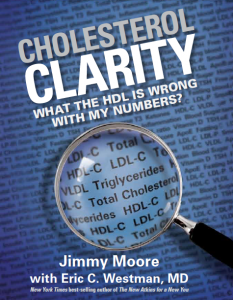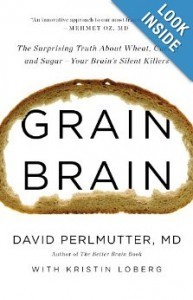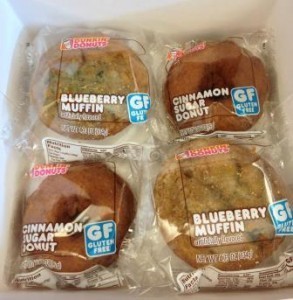William Davis's Blog: Dr. Davis Infinite Health Blog, page 160
September 27, 2013
Surviving wheat withdrawal
Wheat withdrawal can be unpleasant business. Read the many thousands of comments on this blog describing the physical and emotional turmoil that develops in the first few days of wheat avoidance and you will come to appreciate just how awful it can be.
It is important that wheat withdrawal is recognized for what it is, as some people say, “I feel awful. It must mean that I need wheat.” Nope. It is a withdrawal syndrome, a good thing, a transitional phase as your body tries to return to its normal state.
Wheat withdrawal has been labeled by different names over the years–”Atkin’s flu,” “Paleo flu,” “keto flu,” “low carb flu,” etc. Because this only happens with the various forms of carbohydrate restriction (there is no corresponding “low-fat flu” or “Ornish flu”), it has often been attributed to the delayed conversion of a glycogen/glucose-dominant metabolism to that of fatty acid oxidation. This is true . . . but only partly.
Yes, forcing the conversion from a constant flow of carbs from “healthy whole grains” and sugars to increasing the enzymatic capacity to oxidize fats does indeed cause several weeks of low energy–but how do we explain the depression, nausea, headaches, lightheadedness, dehydration, emotional outbursts, intensive wheat cravings, bloating, constipation, even intensification of joint pain, effects that are not likely attributable to hypoglycemia or poor mobilization of energy? Delayed ramp-up of fatty acid oxidation is indeed part of the reason for the phenomena of wheat withdrawal, but does not explain all of it.
Most of these phenomena are caused by withdrawal from the gliadin-derived opiates in wheat, the 4- to 5-amino acid long polypeptides that increase appetite and cause addictive eating behaviors. You can actually trigger the syndrome abruptly in someone who is not wheat-free by giving them naloxone or naltrexone, opiate-blocking drugs. Because it is a form of opiate withdrawal, it cannot be entirely avoided with known strategies. In other words, an alcoholic (not an opiate, of course, but the situation is very similar) who wishes to rid her life of alcohol can only do so by stopping the flow of alcohol and suffering the withdrawal consequences–there’s no way around it. Alcohol withdrawal phenomena, such as hallucinations, disorientation, and seizures, can be blunted with very high doses of benzodiazepines and other drugs, so this is obviously not something you can manage on your own. (The doses required for an alcoholic, for instance, are fatal for non-alcoholics.)
So what can you do to smooth the wheat withdrawal syndrome that involves 1) a soft opiate withdrawal, and 2) delays in gaining higher levels of fatty acid oxidation? Here are a few strategies:
1) Hydrate–Ridding yourself of wheat involves diuresis, or fluid loss. This is due to the loss of the gliadin protein that causes sodium retention, as well as resolving inflammation previously triggered by gliadin-derived peptides, intact gliadin, and wheat germ agglutinin. Urine, for instance, should always be nearly clear, not a dark, concentrated yellow.
2) Use some salt–e.g., sea salt or other mineral-containing salt to compensate for the loss of urinary salt. Salt, along with water, addresses the common lightheadedness symptoms.
3) Take a probiotic–e.g., 50 billion CFUs or more per day containing mixed species of lactobacillus and bifidobacteria. This accelerates the conversion to healthy bowel flora off the disruptive effects of this potent bowel toxin called wheat. This addresses the common bloating and constipation, usually within 24 hours of initiation. This should be necessary for no more than 4 to 8 weeks. (If symptoms such as heartburn or bloating return when probiotics are stopped, this suggests that there is something else wrong, such as failed cholecystekinin signaling to the pancreas, pancreatic enzyme insufficiency, hypochlorhydria, etc. that requires a formal assessment.) Among the best: VSL3, Garden of Life, and Renew Life brands.
4) Supplement magnesium–Magnesium deficiency is widespread and is associated with osteoporosis, hypertension, higher blood sugar, muscle cramps, and heart rhythm disorders. For unclear reasons, these phenomena are magnified during wheat withdrawal. Magnesium supplementation can thereby have some dramatic benefits during wheat withdrawal. Unfortunately, most magnesium supplements are better as laxatives than as sources of absorbable magnesium. Among the best: magnesium malate at a dose of 1200 mg two or three times per day (weight of the magnesium + malate, not just “elemental” magnesium). Source Naturals makes a great preparation.
5) Supplement omega-3 fatty acids–There are plenty of reasons to supplement omega-3 fatty acids to make up for our aversion to consuming the brains of land animals and only occasional reliance on seafood. But during wheat withdrawal, weight loss proceeds at a rapid clip for most people, a process that involves massive mobilization of fatty acids into the bloodstream (evidenced on a cholesterol panel as higher triglycerides). Omega-3 fatty acids partially protect us from the adverse effects of this flood of fatty acids, as it activates the enzyme, lipoprotein lipase, that helps clear them from the bloodstream. I advocate an EPA + DHA intake of 3000 mg per day (the dose of omega-3 fatty acids, not of fish oil). The best fish oil is in the liquid triglyceride form, not the common ethyl ester capsules, as the triglyceride form is better absorbed (particularly the DHA). My favorite brands because of meticulous production techniques: Ascenta NutraSea and Nordic Naturals.
6) Supplement iodine–The average person is marginally deficient in iodine, particularly in people who avoid use of iodized salt. Ironically, the more you avoid processed foods (as we do with wheat elimination, given wheat’s ubiquity), the less iodized salt you get. Avid exercisers also are more iodine deficient than average, given iodine loss via sweat. This has gotten so bad that I have actually found many people with goiters (enlarged thyroid glands). Even a modest lack of iodine leads to lower output of thyroid hormone (especially T4), resulting in mild hypothyroidism that impairs weight loss, can make fatigue worse, increase LDL cholesterol and triglyceride values, and even increase cardiovascular risk. Iodine is an essential trace mineral: everyone needs it (though people with a history of Hashimoto’s thyroiditis or thyroid nodules will have to be extra careful; I’d like to say consult your doctor, which is true if you have a doctor knowledgeable about iodine, which is less than 1% of my colleagues). I advise patients to supplement iodine as inexpensive drops, capsules, or kelp tablets (dried seaweed) to provide 500 mcg iodine per day.
Those are the supplements that have proven tried and true in reducing at least some of the most common struggles with wheat withdrawal. Because these supplements do not entirely address all the issues, especially low energy, I am always on the lookout for ways to make this process easier. On the list of supplements/strategies that we are exploring (and are therefore only speculative for this application):
Generation UCAN–I first learned about this from Peter Attia of The Eating Academy, as he is an avid fan of this polymeric preparation of corn-derived maltodextrin. (Yes: derived from corn that is non-genetically modified and is a purified carbohydrate polymer, no proteins.) It’s unusual lengthy structure of 500-700 glucose residues means it does not yield the osmotic effect of maltodextrins, nor does it cause a rapid rise in glucose, but a very low-grade trickle of glucose. These effects make it useful for very long-distance exercise that depletes glycogen stores and can result in low blood sugar. The slow trickle of glucose form this preparation is usually insufficient to generate much of a rise in blood sugar. This has the potential to prevent the marginal hypoglycemia characteristic of wheat withdrawal when taken, e.g., 1/2 to 1 scoop twice per day. Interestingly, more and more people are observing that, even outside the wheat withdrawal period, weight loss from fat develops. (That’s an entire discussion of its own.)
VESPA–This unique polypeptide preparation from the Asian Mandarin wasp enhances fatty acid beta oxidation, one of the limiting factors in converting from glycogen-dependent metabolism to fatty acid-dependent metabolism. Like Generation UCAN, these lessons have been learned from high-intensity exercise experiences and may be transferable to the setting of wheat withdrawal.
Over the 2+ years since Wheat Belly first made bookstores and upset many people in the wheat world, we’ve learned many new lessons on how to best deal with the phenomenon of wheat withdrawal. If you’ve got some strategies you have found useful, please speak up and post a comment here.
September 19, 2013
Truth in labeling?
This label on Kraft Macaroni and Cheese from the U.K. was brought to my attention by Wheat Belly Facebook follower Jennifer.
While the warning about effects on “activity and attention in children” was meant to warn parents about the potential effects of yellow food coloring, the label nonetheless rings so painfully true.
While we know that food colorings have been associated with impaired attention and learning, as well as heightened impulsiveness, in susceptible children, we also know that wheat consumption triggers similar phenomena in adults.
It’s all about the gliadin protein in wheat, degraded in the gastrointestinal tract to small polypeptides, small enough to penetrate into the brain and affect behavior. Gliadin-derived polypeptides can distort “activity and attention in children,” but also cause mania in bipolar illness, paranoia and hallucinations in paranoid schizophrenics, food obsessions in people prone to binge eating disorder and bulimia, and appetite stimulation and mind “fog” in people without these susceptibilities.
If food companies were indeed required to provide a label revealing such effects on their foods, foods that are the product of extreme and sometimes bizarre methods to introduce novel genetic changes, well, they might have to add: Consume this food at your own risk.
September 18, 2013
Don’t develop Grain Brain!
I call the last 100 years “The century of grains and sugar.”
Over that time period, we’ve witnessed an astounding proliferation of grains, especially wheat and corn, along with sugars (sucrose, high-fructose corn syrup), in the diet of modern humans. Not only do they come through obvious sources in the forms of breads, bagels, corn on the cob, popcorn, and soft drinks, but also in less obvious sources like “heart healthy” breakfast cereals, salad dressings, frozen dinners, and instant soup.
In his just-released new book, Grain Brain: The Surprising Truth About Wheat, Carbs, and Sugars–Your Brain’s Silent Killers, Dr. David Perlmutter furthers the case made by Wheat Belly by educating us about how destructive grains and sugars are on the brain. Among Dr. Perlmutter’s deep interests is dementia. He therefore discusses the science behind grain and sugar consumption and the degeneration of brain tissue characteristic of dementia at length.
Particularly enlightening are his discussions about:
–Brain-derived neurotrophic factor, or BDNF, a protein that is subject to our control and can increase or decrease brain tissue and function.
–The link between statin drug use and impaired brain function–including a section entitled “How carbs–not cholesterol–cause high cholesterol.” Dr. Perlmutter is a neurologist, but understands lipids and lipoproteins better than 99.9% of cardiologists.
–The brain-protective power of ketogenesis–The ketone, beta hydroxybutyrate, in particular, that results from strict carb-restriction and reliance on fatty acid oxidation has potential to provide protection from dementia, as well as potentially enhance mind function and increase metabolic efficiency via stimulating activity and growth of energy-producing mitochondria.
–The brain-enhancing power of exercise–Via BDNF and hippocampal growth responsible for maintaining coordination and balance.
This book is packed with information on how to best preserve brain function over a lifetime. His program starts, of course, with elimination of wheat and sugars, then shows you how to build a program of lifelong brain health using nutrition, exercise, and nutritional supplements.
Add Grain Brain to the short list of recommended reads for the Wheat Belly follower.
September 14, 2013
Steph: “Wheat is not worth it”
I asked Wheat Belly follower and success story, Steph, to share some of her wheat-free experience:

WB: What prompted you to eliminate wheat?
Steph: I had tried a “controlled carb” diet years ago and had some success. Of course, still eating carbs and wheat, it was pretty impossible to stay with this type of eating, especially since eating wheat just makes me lust for more carbs! Once I got interested in what Wheat Belly had to say about how eating wheat makes us want MORE, I had to read the whole thing. Once I did, I thought that the easiest way for me to see for myself was to try it. I went cold turkey on July 2, 2012 and followed the limited/unlimited/forbidden list exactly. I started dropping weight the very first week.
WB: Did you experience a withdrawal process? If so, what did you experience?
Steph: I had a low grade headache for a few days, which is unusual for me.
WB: Have you experienced any improvements in health?
Steph: Have I!?
I lost 70 lbs in less than a year, my blood pressure normalized, my chronic toe-joint pain (hallux limitus) is gone, my sciatic twinges went away. I dropped from a size 22 to a size 12. I wear clothes that don’t even have an X in the size anymore! This is epic!
I don’t feel bloated after eating, and my chronic loose bowels normalized. All of my blood lipid numbers normalized and are now in the “ideal” or “normal” range. The first thing that struck me about the change in eating was the way I started to NOT CARE about eating the carbs. I didn’t think about eating all the time, I didn’t clap my hands in anticipation of going out to lunch. I refused the bread basket when I went out to eat a salad, and I DIDN’T CARE! The change in my mindset about food and eating was the most surprising thing and one of the first things I noticed. This is the one thing I feared about making such a big change in eating the exact things that I loved so much–I feared that I would spend the rest of my life struggling to resist the carbs. So when I realized this was not going to be the case, I was extremely happy!
WB: Can you describe some of your favorite wheat-free foods that help you navigate this lifestyle?
Steph: I enjoy a lot of cheese, meat, including fish dredged in almond flour and different herbs, tomatoes with balsamic vinegar, vegetables, salads, avocados, anything involving coconut, lots of yogurt with nuts (and some reduced-sugar jam mixed in), I LOVE the Wheat Free Market foods muffin mixes, and I eat a lot of pasta sauce or pesto with meat but I just put it over zucchini instead of pasta. (At first I was trying to “noodle” it with a spiral vegetable slicer, but now don’t even bother. Who cares what shape it is? Sliced rounds of zucchini work in place of pasta just as well as “zoodles.”)
My girlfriend is also wheat-free and we discovered how much we love making “chips” out of grated pepper-jack cheese. We eat these like crazy and use them to dip or to eat with goat cheese. Another favorite recipe is making meat lasagna with lengthwise strips of zucchini and eggplant in place of lasagna noodles. Our favorite breakfast is Greek yogurt with nuts and chia seeds, sometimes hemp seeds, and some jam. We also have fun ordering all the “froofie” coffee drinks at our favorite coffee place, and ask for them with “all the fat but sugar-free!”
I have been wheat-free for 14 months (with occasional bite-size backtracking). I was not gluten-sensitive in the sense that it would cause me pain or a lot of discomfort. So there have been times since I have quit wheat that I did eat some forbidden foods, telling myself “Oh, just a little bit just this once,” like a little bit of naan at the Indian restaurant, or cake at someone’s birthday party. There have also been periods where I slacked off on my carb-carefulness (like eating too many rice and beans, or eating corn, or getting too much frozen yogurt). While I do notice a more bloated feeling when I bring grains back into my diet, the biggest problem for me is that the old eating mindset comes back. It makes it much harder for me to wait until I’m truly feeling HUNGRY to eat.
I also am at the point where I realize I am NOT going to lose the last 20 lbs or so of weight I want to lose without regular exercise, which is what I’m starting on this week: a running class with my girlfriend! We feel really good about how we are improving our health, and quitting wheat was the catalyst to all of it. I shudder to think how much wheat I was eating before. Now I shudder to think about going back to my old ways. Wheat is just not worth it!
September 11, 2013
Winner of the first Wheat Belly Challenge!
Melissa Ann is the winner of the first Wheat Belly Challenge that I posted on the Facebook page for Wheat Belly!
Take a look at what she accomplished:
Isn’t that an incredible transformation? Melissa Ann tells us that she is down an astounding 184 pounds over 2 1/2 years! “No wheat will ever touch my lips again!”
We will send Melissa Ann a copy of the new Wheat Belly 30-Minute Meal Cookbook when it become available in December, 2013.
September 6, 2013
Dunkin’ Donuts to the rescue?
Dunkin’ Donuts has announced their new line of gluten-free donuts, such as gluten-free Cinnamon Sugar Donut and a gluten-free Blueberry Muffin.
If it’s gluten-free, it must be good! Right?
Wrong. Fatally, irreversibly wrong. Dunkin’ Donuts is not the first to make this nutritional blunder. Post, Kelloggs, Nabisco, as well as Udi’s, Schar, and Glutino, have all demonstrated their incredible ignorance on nutritional issues, or at least their indifference.
Let’s take a source of starch, such as corn. (Let’s put aside modern issues, including genetic-modification of the corn plant, glyphosate residues, Bt toxin content, and breeding efforts to increase amylopectin/amylose content.) Let’s take “corn” as the intact kernels on a cob. This raises blood sugar substantially with a glycemic index of 52 to 60.
Now dry and pulverize the corn into cornmeal or cornstarch. By doing this, we increase the surface area for digestion exponentially, making digestion via the salivary and stomach enzyme, amylase, rapid and highly efficient. Glycemic index now? 78 for gluten-free corn pasta, 100 for cornstarch. Now that’s high.
Also note that the starch in cornstarch is typically the most rapidly digested amylopectin, not the somewhat less rapidly digested amylose (often called a “safe starch,” a misnomer because it is just a less harmful starch, not safe, another example of the flawed logic of nutrition).
So gluten-free donuts–or multigrain bread, bagels, muffins, or pretzels–are rapidly digested and yield very high blood sugars. This triggers insulin to high levels, which then leads to tissue insulin resistance which, in turn, leads to high blood sugar, high blood insulin . . . around and around, causing visceral fat accumulation, diabetes and all the phenomena of glycation: cataract formation, hypertension, kidney disease, heart disease, joint degeneration and arthritis, some forms of cancer, and dementia.
So NO member of the species Homo sapiens should be consuming such gluten-free products made with cornstarch, rice flour, tapioca starch, or potato starch. Once again, processed food manufacturers have, with their eagerness to generate profits at your expense, created something awful for health under the guise of something “healthy.”
(Note that I have a delicious recipe for healthy donuts in my upcoming Wheat Belly 30-Minute Meal Cookbook due out this December!)
August 28, 2013
My interview for Jimmy Moore’s Cholesterol Clarity
Jimmy Moore of the Livin’ La Vida Low Carb Show has posted my interview that helps launch his new book, Cholesterol Clarity. 
In this interview, as in his Cholesterol Clarity book, Jimmy takes apart the arguments of the Lipid Hypothesis that have been used to justify an entire nation prescribed statin drugs. In addition to my comments, he includes the insightful commentary of Dr. John Briffa, Dr. Ronald Krauss, Dr. Malcolm Kendrick, Dr. Chris Masterjohn and others.
I posted my thoughts as a book review on the book’s Amazon page:
Cholesterol bashing at its finest
Widely-held beliefs, many of them propagated by “official” agencies like the FDA, USDA, American Heart Association, Academy of Dietetics and Nutrition, American Diabetes Association, etc., are crumbling under the scrutiny of informed people uninfluenced by the pharmaceutical industry, agribusiness, or the excessive profiteering ways of modern “healthcare.”
In Cholesterol Clarity, Jimmy Moore, along with the help of a couple of dozen other vocal critics of the Lipid Hypothesis, systematically take apart the flawed logic often used to justify a $23 billion per year statin drug industry. He exposes the overly-simplistic thinking and the “research” used to prop up this example of how far wrong medical care can go when richly funded. Jimmy shows how the fiction that “cholesterol causes heart disease” belongs with other fairy tales like “Cut your fat and saturated fat for heart health” and “Fat makes you fat.”
We live in a time when the messages in health have been distorted by bad science and biases introduced by corporate interests that stand to gain from a campaign of half-truths. In his characteristically genuine and straightforward style, Jimmy helps the reader understand how to navigate the real arguments behind heart disease risk unemcumbered by self-serving financial interests.
High cholesterol causes heart disease, cut your fat and saturated fat, a calorie is a calorie, everything in moderation, eat more “healthy whole grains” . . . the fairy tales of the 21st century!
August 26, 2013
Wheatlessness goes worldwide!
The original Wheat Belly book is now in 18 languages: French, German, Korean, Japanese, Portuguese, Polish, Turkish, Romanian, Chinese, and a few others. And, oh yes, in Australian, too, Dannie!
August 21, 2013
More on Dawn’s big wheat-free success!
We’ve lately been parading out some pretty spectacular success stories of people engaging in the Wheat Belly wheat-free lifestyle on the Wheat Belly Facebook page. Dawn wowed us with her story and photos:
“75 lbs off, high blood pressure meds gone, no longer pre-diabetic–sugar levels normal!. No more anti-depressants. I have gone from a tight size 16 to size 2/4!!
Weight has been off over a year, the longest I’ve ever maintained a loss!!!
This tidal wave of success stories like Dawn’s has prompted many readers to ask for the details. Many people enjoying success are doing so with slightly different approaches: Some exercise, while others don’t. Some slash total carbohydrates beyond wheat, while others simply eliminate the Most Evil Grain of All. (This is not a controlled clinical trial, after all, but a real world experience with real people living their lives.)
Nonetheless, I’d like to post a series of brief Q&A’s with the people sharing these wonderful success stories so that readers can get an appreciation for what they are doing. Here are the details of Dawn’s experience:
What prompted you to eliminate wheat?
I was told by my doctors that I was pre-diabetic. They told me to eliminate everything white from my diet–and I interpreted that as wheat, sugar, potatoes, rice. I was already suffering from a number of other ailments (obesity, high blood pressure, high cholesterol, glaucoma suspect, bad knee), so I figured I needed something to help me.
Did you experience a withdrawal process? If so, what did you experience?
No withdrawal. I ate a lot of fruit when I wanted something sweet.
After about a week, I had no cravings for any wheat or sugar-related products.
Have you experienced any improvements in health?
75 lb weight loss, kept off for over a year (best ever), normal blood pressure without pills, no more anti-depressant meds, off of cholesterol meds, glaucoma less of an impending problem (probably more from exercise, but losing weight helped me exercise more).
Because of rehab, orthotics and losing weight, I can exercise an hour or more at a time, so I’m in great shape and can walk for miles at a time. Obesity made me depressed and lacking in energy and self-confidence, for which I turned to an antidepressant. Since losing the weight and exercising, my mood is great without it!”
Can you describe some of your favorite wheat-free foods that help you navigate this lifestyle.
I eat an apple with natural chunky peanut butter every day for breakfast. If I can’t get that, I have an egg white omelet with cheese and veggies mixed in.
For lunch, I might have that again, or a salad with beans and protein, or even Kentucky Fried Chicken without the skin.
For dinner, I try to eat chicken or fish and veggies. If I really need a starch, I use quinoa, but it’s rare.
I find I can eat wherever I go: Thai (Veggie Curry), Mexican (chicken, beans, cheese, or I eat the insides of a fajita), Italian (I eat the toppings off of veggie pizza or I have fish or chicken), fast food (the inside of the grilled chicken sandwich), Indian (Chicken Tikka Masala without rice or Vegetable Korma without rice–I eat it on top of salad). You can always make anything work if you set your mind to it.
I snack on nuts, fruit, tea with coconut/almond milk.
I try to exercise 5 mornings a week for at least 30 minutes. I try to get at least 3 miles in on the elliptical or lift weights or take a class.
Dawn went beyond cutting out wheat by cutting out other rapidly-digested carbohydrate sources. She also exercised. The predominant effect of wheat elimination for Dawn appears to be freedom from appetite-stimulation from the gliadin-derived opiates of wheat and probable freedom from the depressive effects of the same opiates. But she did nothing particularly extraordinary beyond just sticking with these changes, yet obtained some spectacular benefits.
Anyway, another congratulations, Dawn, on your newly-rediscovered health!
August 15, 2013
I will be speaking in Denver Monday, Aug 19th!
Don’t forget: Wheat Belly is coming to Denver, Colorado, this coming Monday!
I will be speaking at the University of Denver’s Newman Center for the Performing Arts at 7:30 pm on August 19th, 2013. I will discuss all the important arguments underlying the success of the Wheat Belly approach, as well as feature a new video of spectacular success stories! I will also discuss some new strategies to help maximize success once you banish wheat from your life.
Purchase tickets at the Newman Center Box Office (SW corner of University and Iliff) Mon-Fri 10 am-4 pm or order online at www.newmantix.com or by calling 303-871-7720.
Bring your story of wheat-free success with you!
This begins a series that we call The Experience Wheatlessness Tour that will be coming to other major cities in the U.S. and Canada over the next year.
Dr. Davis Infinite Health Blog
Recognize that this i The insights and strategies you can learn about in Dr. Davis' Infinite Health Blog are those that you can put to work to regain magnificent health, slenderness, and youthfulness.
Recognize that this is NOT what your doctor or the healthcare system provides, as they are mostly interested in dispensing pharmaceuticals and procedures to generate revenues. The healthcare INDUSTRY is not concerned with health--you must therefore take the reins yourself.
Dr. Davis focuses on:
--Real, powerful nutritional strategies
--Addresing nutrient deficiencies unique to modern lifestyles
--Deep insights into rebuilding the microbiome disrupted by so many modern factors
Follow Dr. Davis here and on social media and you can witness the extraordinary successes people enjoy on his programs. ...more
- William Davis's profile
- 159 followers









